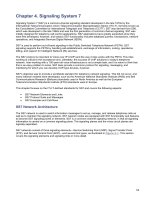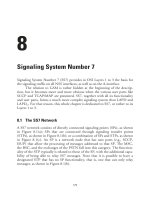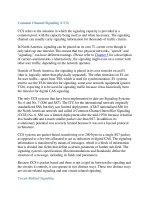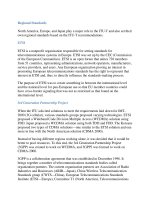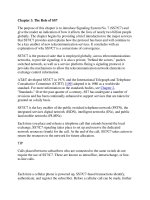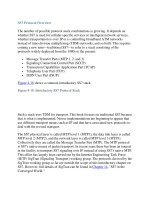Signaling System Number 7
Bạn đang xem bản rút gọn của tài liệu. Xem và tải ngay bản đầy đủ của tài liệu tại đây (215.26 KB, 27 trang )
8
Signaling System Number 7
Signaling System Number 7 (SS7) provides in OSI Layers 1 to 3 the basis for
the signaling traffic on all NSS interfaces, as well as on the A-interface.
The relation to GSM is rather hidden at the beginning of the descrip-
tion, but it becomes more and more obvious when the various user parts like
SCCP and TCAP/MAP are presented. SS7, together with all its functionality
and user parts, forms a much more complex signaling system than LAPD and
LAPD
m
. For that reason, this whole chapter is dedicated to SS7, or rather to its
Layers 1 to 3.
8.1 The SS7 Network
A SS7 network consists of directly connected signaling points (SPs), as shown
in Figure 8.1(a); SPs that are connected through signaling transfer points
(STPs), as shown in Figure 8.1(b); or a combination of SPs and STPs, as shown
in Figure 8.1(c). An SP is a network node that has user parts (e.g., SCCP,
ISUP) that allow the processing of messages addressed to that SP. The MSC,
the BSC, and the exchanges of the PSTN fall into this category. The function-
ality of the STP typically is related to those of the SP, with the additional capa-
bility of being able to relay SS7 messages. Note that it is possible to have a
designated STP that has no SP functionality, that is, one that can only relay
messages, as shown in Figure 8.1(b).
125
8.2 Message Transfer Part
SS7 without user parts consists only of the OSI Layers 1 through 3. Those three
layers essentially are represented by the message transfer part (MTP). Parts of
the SCCP actually are also part of Layer 3.
The MTP of SS7 performs the following general tasks:
•
It provides all the functionality of OSI Layers 1 to 3 required to pro-
vide for a reliable transport of signaling data to the various SS7 user
parts.
•
When problems arise, the MTP takes the necessary measures to ensure
that the connection can be maintained or prevents loss of data, for
example, by switching to an alternative route.
The MTP can be partitioned into three layers, where the MTP 1 (OSI Layer 1)
is responsible for the transfer of single bits or the definition and provision of the
necessary electrical and physical means for it.
The MTP 2 (OSI Layer 2) defines the basic frame structure that is used
by SS7 for all message types. This frame structure is illustrated in Figure 8.2,
which shows the flags that mark beginning and end (as we have seen in LAPD),
126 GSM Networks: Protocols, Terminology, and Implementation
SP SP
Figure 8.1(a) Directly connected SPs.
STP
SP
SP
SP
SP
SP
SP
Figure 8.1(b) An STP that interconnects SPs.
STP
SP
SP
SP
SP
SP
SP
SP
Figure 8.1(c) An STP with SP functionality that interconnects SPs.
an acknowledgment field with send and receive sequence numbers, a length
indicator, an optional information field, and the FCS to transport a checksum
(as we also have seen in LAPD).
8.3 Message Types in SS7
Definition of the SS7 message types is another functionality of MTP 2. In
Layer 2 of SS7, three different message types are defined: the fill-in signal unit
(FISU), the link status signal unit (LSSU), and the message signal unit (MSU).
Although no explicit field is available to distinguish among the message types, it
is possible to do so based on their different lengths. The length indication (LI)
provides that information and relates to the length of the optional data field.
The value of the LI is always 0 for FISUs; 1 or 2 for LISUs; and greater than
2 for MSUs.
8.3.1 Fill-In Signal Unit
The FISU (Figure 8.3) is used to supervise the link status when no traffic
is available. Both sides poll each other in this idle state. The N(S) and N(R),
which in SS7 are called the forward sequence number (FSN) and backward
sequence number (BSN) or the forward indicator bit (FIB) and backward indi-
cator bit (BIB), respectively, do not change their values during polling. In addi-
tion to the polling functionality, an FISU also can be used to acknowledge
receipt of an MSU.
Signaling System Number 7
127
FCS
Length
Flag
Flag
Information field (optional)
Acknowledgment
Figure 8.2 General format of an SS7 message.
FCS
11 7 bit7 bit6 bit
LI BSNFSN
BIB
FIB
16 bit
LI 0=
8 bit
Flag
8 bit
Flag
2
Figure 8.3 Format of the FISU.
8.3.2 Link Status Signal Unit
The LSSU is used only to bring a link into service or to take it out of service
and during error situations (e.g., overload), to exchange status information
between two SPs or STPs. In Figure 8.4, the status field has a length of 1 byte,
but according to ITU definitions it also can be 2 octets long. In any case, only
the first three bits of the first byte contain the actual status information. The
receiver of an LSSU does not confirm its receipt.
Protocol test equipment usually does not indicate an LSSU as such but
displays it according to its status field. For that reason, the status field or
its abbreviation can also be used as a subname. Consequently, the term status
indication (SI) and the terms SIO, SIOS, and SIB, which are explained in
Table 8.1, are used more frequently than LSSU/status field SIOS. Note that, in
particular, when SIPOs or SIBs are detected during protocol testing, rather
serious problems can be expected at the related SP/STP.
8.3.3 Message Signal Unit
The MSU (Figure 8.5) is used for any type of data transfer between two net-
work nodes. The MSU is the only SS7 message able to carry traffic data (the
LSSU does not carry traffic data, only status information), and it is used by all
user parts (ISUP, SCCP, OMAP) as a platform particularly for that task. The
information field of the MSU consists of the service information octet (SIO)
128 GSM Networks: Protocols, Terminology, and Implementation
FCS
11 7 bit7 bit6 bit
LI 1 (or 2)=
Spare
LI
BSNFSN
BIB
FIB
16 bit
8 bit
Flag
8 bit
Flag
2
35
Status
}
Status field (SF)
76543210Bit
00000000 00 SIO "Out of alignment"
00000001 01 SIN "Normal" alignment status
00000010 02 SIE "Emergency" alignment status
00000011 03 SIOS "Out of service"
00000100 04 SIPO "Processor outage"
00000101 05 SIB "Busy/congestion"
=> = =
=> = =
=> = =
=> = =
=> = =
=> = =
Figure 8.4 Format of the LSSU.
Signaling System Number 7
129
Table 8.1
Status Field Values
Value Abbreviation Status Description
0 SIO Out of alignment Start of link alignment
1 SIN Normal alignment A connection is brought into service with a
normal (long) surveillance time of 8.2 s
(see also Section 8.4.2).
2 SIE Emergency alignment A connection is brought into service with
an emergency (short) surveillance time of
about 500 ms. (see also Section 8.4.2).
3 SIOS Out of service This indicates in case of an error situation
or before a link is taken into service that
currently no MSUs can be sent or
received.
4 SIPO Processor outage When the Layer 2 of an SP or STP detects
a problem within the Layer 3 of its own
network node it indicates the problem
status to the peer entity by sending a SIPO.
5 SIB Busy/congestion Signals overload on the originating side.
Acknowledgments cannot be sent
anymore. Usually, a link failure follows.
FCS
11 7 bit7 bit6 bit
LI
BSNFSN
BIB
FIB
16 bit
LI 2>
8 bit
Flag
8 bit
8 bit
Flag
2
SIOSIF
N*8bit
NI
3210bit
0011 3 Sign. Conn. Control Part (SCCP)==>
0010 2 Oper. & Maint. Appl. Part (OMAP)==>
0100 4 Telephone User Part (TUP)==>
0110 6 Data User Part (only for call administration)==>
0101 5 ISDN User Part (ISUP)==>
0111 7 Data User Part (for Supplementary Services)==>
0001 1 Sign. Network Test. Maintenance==> +
0000 0 Sign. Network Management==>
1100
1000
0000
7654
0100
National 0 8<= <=
International 1 4<= <=
International 0 0<= <=
National 1 C<= <=
}
SI
}
}
SSF
Figure 8.5 Format of the MSU.
and the signaling information field (SIF). The SIO
1
is further partitioned into
the subservice field (SSF) and the service indicator (SI), with four bits each.
Only the two bits of higher valence in the SSF are necessary to describe the net-
work indicator (NI). The NI is used to distinguish between national and inter-
national messages. The SI indicates to which user part an MSU belongs. The
four bits of the SI thus determine whether the data of the SIF belong to
the SCCP, TCAP, ISUP, and so on, or possibly need to be forwarded to the
automatic network management. In contrast to LSSU and FISU, it has to be
acknowledged to the peer entity whenever an MSU is received.
8.4 Addressing and Routing of Messages
In an SS7 network, MSUs are not necessarily exchanged between adjacent
neighbors (SP/STP). In a GSM system, the MSC and BSC are neighbors; how-
ever, the exchange of information between the MSC and the HLR may involve
several STPs. SS7 uses so-called point codes for routing and addressing MSUs.
Point codes are unique identifiers within an SS7 network. Exactly one point
code, a signaling point code (SPC), is assigned to every SP and STP. An MSU
has a routing label that contains the point codes of the sender (the originating
point code, or OPCs) and the addressee (the destination point code, or DPC).
The routing label is, for its part, a component of the SIF. Note that neither
FISU nor LSSU possesses a routing label, since those messages are exchanged
only between two adjacent nodes.
Figure 8.6 shows the format of a routing label. The OPC defines the
sender of the MSU, and the DPC defines its addressee. Note that addressing via
SPCs works only on a national basis. The services of higher layers are needed
for international addressing, in particular SCCP or ISUP, to provide the neces-
sary features.
The remaining 4 bits of the routing label form the signaling link selection
(SLS) field. This parameter is used to balance the load between several SS7 con-
nections of a link group. If, for example, two SS7 connections are available
between two network elements, all the even values of the SLS (0, 2, 4,… ,14
dez
)
are assigned to the first link, and the odd values (1, 3, 5,… ,15
dez
) are assigned
to the second link. This fact is important to know in the analysis of SS7 trace
files.
130 GSM Networks: Protocols, Terminology, and Implementation
1. Note that the service information octet and its abbreviation SIO do not have a relation to
the former use of the abbreviation, which stood for status indication/out of alignment. Un-
fortunately, the standards use the same abbreviation for both.
8.4.1 Example: Determination of DPC, OPC, and SLS in a
Hexadecimal Trace
In the analysis of hexadecimal trace files, it generally is important to be able to
convert DPC and OPC into clear text, to be able to relate the various messages
to, for example, a particular MSC or BSC. As shown in Figure 8.6, DPC and
OPC are each 14 bits long. The routing label, together with the 4 bits of the
SLS, totals 32 bits, or 4 bytes.
Because the OPC and the DPC are 14 bits in length, it is not trivial, par-
ticularly with byte (8 bits) or 16-bit-word-oriented presentations, to derive the
decimal value of DPC or OPC, as illustrated in Figure 8.7. The sequence of
numbers represents the hexadecimal values. The underlined part represents the
routing label, that is, the SLS, OPC, and DPC. This information is decoded in
clear text. At first sight, the values seem to differ.
It is important when decoding to consider the bitwise sequence of trans-
mission with which the data are received by the system. The binary presenta-
tion (left to right) is given in Figure 8.8.
Signaling System Number 7
131
Routing Label
LSD MSD
9E EC 0F 83 00 2E 88 CB 06 22 81 31 00 01 03 00 01 21
2E00
hex dez
==DPC 11776 2E20
hex dez
OPC 11808== C
hex dez
SLS 12==
Figure 8.7 Partial trace file and point codes.
1100 1011 1000 1000 0010 1110 0000 0000
}
}
}
}
}
}
}
}
CB 8 8 2 E 0 0
DPC 10 1110 0000 0000 2E 00 11776===
dez
SLS 12=
dez
OPC 10 1110 0010 0000 2E 20 11808===
dez
Figure 8.8 Transmission of routing label.
14 bit
OPC
SLS
DPC
14 bit
4
31 0 bit1327
Figure 8.6 Routing label (DPC, OPC, and SLS).
Possible confusion is based on the unusual length (14 bits) of OPC and
DPC on the one hand, and, on the other hand, the results from the reversed
way of reading/writing (right to left), a problem familiar to most programmers.
Misinterpretation can be prevented when these facts are considered.
Other representations of SPCs can be used in various national applica-
tions, like the “4-3-4-3” presentation, which refers to the bits that are used per
sign. The example in Figure 8.7 reads in the “4-3-4-3” presentation as follows:
DPC = 2E00
hex
= 11776
dez
= 1011 − 100 − 0000 − 000 = B − 4 − 0 − 0
OPC = 2E20
hex
= 11808
dez
= 1011 − 100 − 0100 − 000 = B − 4 − 4 − 0
8.4.2 Example: Commissioning of an SS7 Connection
Every SS7 connection is brought into service as presented in Figure 8.9. In the
figure, an A-interface link between BSC and MSC is brought into service.
8.4.2.1 Bringing Layer 2 Into Service
After Layer 1 is established, both sides send an SIOS-LSSU, which indicates
that the link is out of service and no MSU can currently be processed.
The process to bring Layer 2 into service starts with sending an
SIO-LSSU. Please note the duplex characteristics of SS7. Both terminals are
equal, and a link has to be established in both directions.
The test period, during which both sides examine the link quality, starts
with sending an LSSU-SIN or an LSSU-SIE. Transmitted FISUs must not
contain any errors during this test period. The link cannot go into service if an
error occurs. The difference between LSSU-SIE and LSSU-SIN is the related
surveillance time.
An emergency alignment is used when no alternative SS7 route currently
exists and the link needs to be in service as quickly as possible.
8.4.2.2 Bringing Layer 3 Into Service
When the test time is over and no errors were detected, Layer 2 is considered to
be in service and Layer 3 initiates further tests. A signaling link test message
(SLTM) is used for that purpose, to transmit a number of test bytes to Layer 3
of the peer entity.
If the test bytes are correctly returned to the sender in a signaling link test
acknowledgment (SLTA) message, Layer 3 is also considered to be “in traffic.”
Figure 8.10 shows examples of a SLTM and a SLTA message.
132 GSM Networks: Protocols, Terminology, and Implementation
Synchronization of Layer 4 (in this case of the SCCP) follows the link
establishment on the A-interface, by applying the reset procedure (described in
Chapter 10).
8.5 Error Detection and Error Correction
Layer 2 is responsible for error detection and error correction. To be more spe-
cific, within Layer 2, the FSN and the BSN, together with the FCS, take care
Signaling System Number 7
133
A-interface
SS7 out of service (idle state)
LSSU/SIO
"Out of alignment"
Establishment of Layer 2
from BSC MSC→
Establishment of Layer 3
from MSC BSC→
Establishment of Layer 3
from BSC MSC→
Establishment of Layer 2
from MSC BSC→
LSSU/SIOS
"Out of Service"
LSSU/SIO
"Out of alignment"
LSSU/SIN or SIE
normal or "Emergency alignment"
LSSU/SIN or SIE
normal or "Emergency alignment"
Definition of the test duration
SIN 8.2 s, SIE 0.5 s==
Definition of the test duration
SIN 8.2 s, SIE 0.5 s==
Test duration
SS7 in service
BSC
MSC
LSSU
"Out of service"/SIOS
MSU/SLTM
with DPC and OPC
MSU/SLTM
with DPC and OPC
MSU/SLTM
with DPC and OPC
MSU/SLTM
with DPC and OPC
Test duration
Figure 8.9 Establishment of an SS7 link.
of the error recognition function. Note that the format of those parameters is
the same for all three message types (FISU, LSSU, MSU). Refer to Figures 8.3
through 8.5.
134 GSM Networks: Protocols, Terminology, and Implementation
Signaling link Test Message (SLTM)
----0001 Service Indicator Sig network test & maint mess
--00---- Sub-Service: Priority Spare/priority 0 (U.S.A. only)
10------ Sub-Service: Network Ind National message
******** Destination Point Code 1024
******** Originating Point Code 1035
******** Signalling Link Code 0
----0001 Heading code 0 0x1
0001---- Heading code 1 0x1
----0000 Spare
0111---- Length indicator 7
******** Test pattern 44 43 4E 20 53 53 37
Signalling link Test Ack mess (SLTA)
----0001 Service Indicator Sig network test & maint mess
--00---- Sub-Service: Priority Spare/priority 0 (U.S.A. only)
10------ Sub-Service: Network Ind National message
******** Destination Point Code 1035
******** Originating Point Code 1024
******** Signalling Link Code 0
----0001 Heading code 0 0x1
0010---- Heading code 1 0x2
----0000 Spare
0111---- Length indicator 7
******** Test pattern 44 43 4E 20 53 53 37
Figure 8.10 Examples of a SLTM and a SLTA message.
